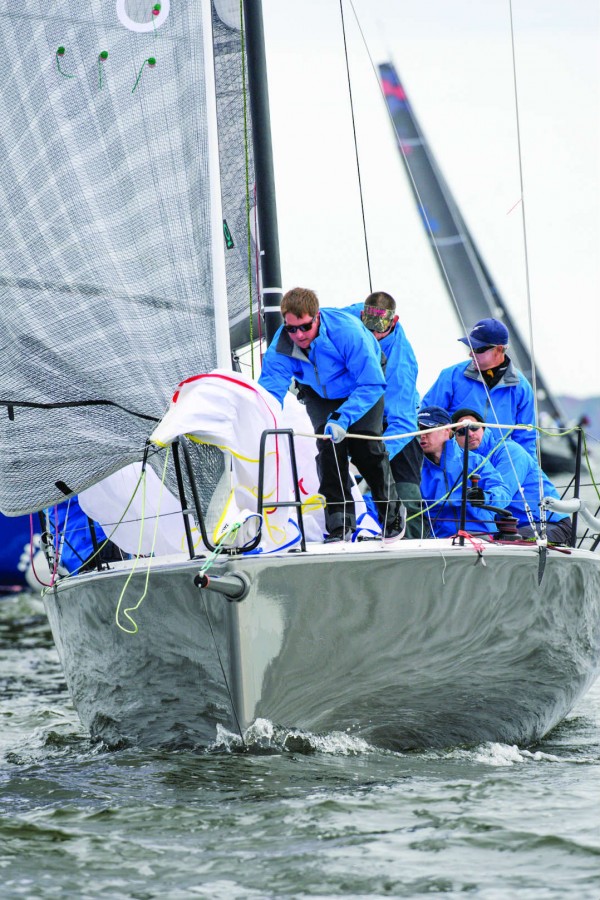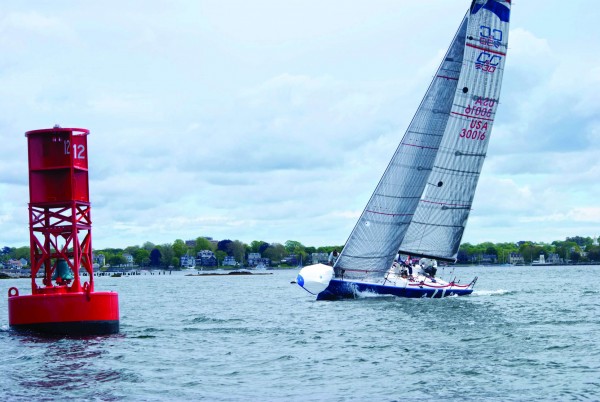In previous parts of this series we have covered tacks and gybes. Now a few words of wisdom on getting spinnakers up in a timely fashion. Fortunately, for the most part, the key principles apply to both asymmetrical and symmetrical spinnakers.
In times of peace prepare for war…
If you are waiting until the weather leg to get things hooked up, it’s too late. For course racing (windward/leewards), the marks will be to port, and with the exception of an occasional gybe set, sets will be simple bear-aways. This means the gear (halyard, sheets, tack line for asymmetrical) will be to port.
I am a big fan of launching from the forward hatch just like the big boys do even on older designs. Everything can be hooked up before the start except for the spinnaker halyard on boats using genoas. For non-overlapping designs, the halyard can be hooked on from the get go. Secure the tail to a keeper shackle (or tape, or velcro, or tie) at the shrouds to keep it out of the way going upwind. For those with a genoa, you will have to wait until the penultimate tack to hook the halyard to the head and then caddie it (make sure it doesn’t get hung up on sail or spreader during the last tack).
If you have more than one spinnaker, get your tactician/speed doctor to choose a sail before the start. If you are using a spinnaker pole, it can usually be hooked to the mast at the base or to a shroud with the afterguy, topping lift, and foreguy already in place, so it will just be a matter of popping the pole up into place on the mast and hoisting the topping lift.
Always do a practice set before the start of a race. To be sure that you get everything hooked up correctly the first time. This is particularly important on modern, high-performance boats with “string drop” systems. Invariably, the string for the drop system will be wrapped around something it is not supposed to be.
Take your time and stay on the rail…
Just as “ready about” prior to a tack is not a signal for a mass exodus from the weather rail, getting ready for a spinnaker set only needs minimal movement. The last thing you want to do as you are struggling to make the weather mark is to have crew out of position and lots of movement. If there is an offset mark, nothing has to happen until the weather mark is rounded.
On symmetrical boats, the only required movement is the bow person moving to get the pole up and the spinnaker pulled to meet the outboard end of the pole. The topping lift can be tailed by the pit person from the weather rail, as can the slack in the afterguy. On asymmetrical boats, only the tack needs to get pulled out to the end of the pole (which may need to be pulled out as well).
Again it is just the bow person and a pit assist pulling from the rail. (In light air, pull from wherever you are out of the way and your weight is low). There is absolutely no need for any other crew to be out of position.
The spinnaker sheet itself is absolutely the last you need to worry about. It does not need to be touched until the sail is 75 percent of the way up. One potential issue is the lazy sheet. All too often the lazy sheet is tight, cleated, or wrapped around something. A good practice is to pre-pull a bunch of the lazy sheet forward into a pile in front of the shrouds prior to the set.
There is a magic moment…
It is always a big rush to get the spinnaker up. Chill… Don’t move until the boat has turned down. The magic moment when everything should happen is just as it goes flat. Spring into action. Jump the halyard like a mad man/woman (watching to make sure the sail is not hung up and going to rip on something). Take a little tension on the sheet to separate the corners, but don’t pull the clew much past the shrouds. The sheet should be undertrimmed so that the sail does not fill on the way up.
Trim only once at full hoist. A call of “made” from the person jumping the halyard at the mast is helpful. On symmetrical boats, pull the pole back to target angle as the sail is hoisted. Don’t pull too far aft. With an asymmetrical, be ready to ease the sheet as soon as it fills. It will probably be overtimed initially.
The helmsperson can make or break the whole thing…
The goal is to turn smoothly from close hauled to broad reach. Turn too fast, and you will end up too deep (with the wind too far aft). The spinnaker will be blanketed behind the mainsail and will twist and collapse. Turn too slowly and don’t get down far enough, and the boat will heel over; the spinnaker will be hard to get up and will fill too early. Just as with tacks and gybes, there is a perfect exit angle right in the middle. Get it right, and the rest will of the set will follow
Get the jib down…
The spinnaker will not fill until the jib is down, or at least eased and completely luffing. The lighter the air, the more important it is to get the jib out of the way. The headsail can be coming down as soon as the spinnaker is more than 75 percent of the way up. In heavy air with a small jib up, it is okay to leave the sail up and keep the weight off the bow while you get the crew in the right place and the boat under control. Just make sure the jib is well-eased.
The sail is up, so freeze… Movement kills speed. As soon as the sail fills get in the appropriate spot for the conditions. (Forward and to leeward in light air, aft and to weather in more breeze). Then, don’t move. Settle the boat down. No panic to get the outhaul, cunningham, or backstay off. That can come anytime. If you have taken the jib down and want to flake it, wait. The fastest thing you can do once the spinnaker is up and full is freeze.






